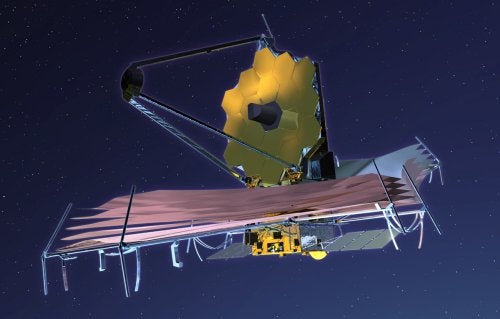Originally called the Next Generation Space Telescope, the Webb telescope naturally has been seen by the public as a successor to the Hubble Space Telescope. But that idea is misleading — JWST has more in common with the current Spitzer Space Telescope. Spitzer observes the universe in the infrared part of the electromagnetic spectrum, just as JWST will. The Webb telescope will cover the wavelength region from 0.6 to 28 micrometers, or from the red end of the visible spectrum well out into the infrared. And it will be optimized for observations in the 1 to 5 micrometer range.
The major goal for JWST is to observe the first stars and galaxies in the universe. And that’s where the need for a large space telescope that can detect infrared radiation comes in. These objects lie so far away that the expanding cosmos shifts their light well to the red. Astronomers measure the amount of this change, the so-called redshift, to determine how far away an object lies. A galaxy with a redshift of one has had its light shifted by 100 percent — in other words, the wavelengths it emits have doubled — and lies halfway across the universe, about 7 billion light-years away.
But to go back to the era when stars and galaxies were forming requires looking 10 billion to more than 13 billion light-years away. The redshifts then can be five or more. A galaxy at a redshift of five, for example, has the wavelengths of its light shifted by 500 percent. That means even ultraviolet radiation at a wavelength of 0.3 micrometer will be shifted to a wavelength of 1.8 micrometers, into the near-infrared.
To accomplish its mission, JWST will employ a 6.5-meter mirror, nearly three times the diameter of Hubble’s mirror and more than seven times that of Spitzer’s. New technology means the mirror, which consists of 18 segments made primarily of beryllium, weighs just one-third of Hubble’s primary mirror. The mirror will deliver a resolution of about 0.1 arcsecond, comparable to Hubble.
After launch, currently scheduled for August 2011, JWST will be placed in an orbit around the L2 Lagrangian point of the Sun-Earth system. This spot lies on a line from the Sun to Earth that has been extended about 1 million miles farther into space beyond our planet. An object at the L2 point will stay in place relative to both the Sun and Earth, so JWST will keep up with Earth as our planet orbits the Sun. Observing from L2 provides a stable thermal environment and keeps the three objects whose light would most interfere with observations — the Sun, Earth, and Moon — all in the same direction. NASA is already using the L2 point for the Wilkinson Microwave Anisotropy Probe, which has revolutionized our knowledge of the cosmic background radiation. With any luck, the James Webb Space Telescope will prove equally adept at helping astronomers understand how galaxies form and evolve.










